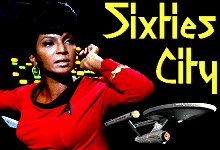

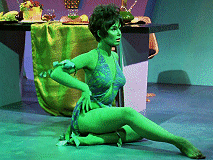
 |

|
 |
| On September 8th,
1966 at 8:30 pm on NBC, America received its first glimpse of what was to
become a legend. Star Trek made its debut that night, and America was never
to be the same. For three years Star Trek graced the network, only to be
cancelled and to later return in syndication. Only then did the series command
the reputation it deserved, but Star Trek has never been a run-of-the-mill
science fiction program. One might find great difficulty in trying to compare it to other television science fiction series, like Space: 1999 (which competed with Star Trek during its run in syndication), or series produced in the 1980's, like Battlestar Galactica or Buck Rogers in the 25th Century. Comparison is difficult because Star Trek is not simply a far-out science fiction program - it is a science fiction program that reflects the America of the 1960's. Indeed, Gene Roddenberry, the creator of Star Trek, during one interview is quoted as saying: "I have no belief that STAR TREK depicts the actual future - it depicts us, now, things we need to understand about that" and David Gerrold, a writer for the series, says in his book that "[the] stories are about twentieth century man's attitudes in a future universe. The stories are about us". Of course not every single episode makes a social commentary, but throughout the series, characters, themes, motifs and, of course, individual episodes make strong comments on sexism and feminism, racism and improving race relations, as well as militarism and peace - all major social issues during the late 1960's and, to a different degree, social issues of today. |
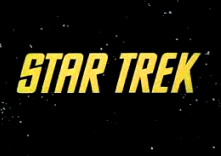 |
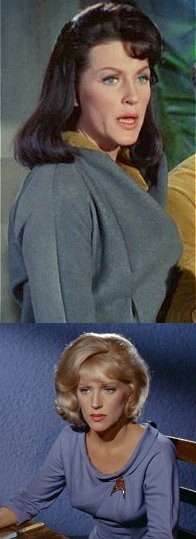 |
It
was during the late 1960's that the contemporary feminist movement began.
Major progress in women's rights in America was still years off, but the
movement was gaining strength in the face of backward and reactionary ideas.
Star Trek was almost destined to collide with the movement for women's rights
in some way or another. Star Trek's attitude towards women was intended
to be progressive from the very beginning. However, circumstances would
not permit this progressive attitude of women as full equals to their male
counterparts to achieve its proper position. Instead, the series seemed
to embody the 1960's status quo as far as relations between the sexes and
the role of women was concerned. Star Trek had the opportunity to have a woman play a character in a clear authority position but it instead backed off, preferring to use regular female characters that either came just short of what was originally envisioned or reaffirmed the traditional roles for women. According to Karen Blair, the rest of the female characters that appear in Star Trek are shallow, femme-objets that are disposed of at the end of each episode. In the earliest conception of the series and during the first pilot, the script called for a character by the name of 'Number One', the female first officer of the U.S.S. Enterprise. A strong, cool, almost emotionless character, she was intended to have experience and knowledge of ships' operations superior to that of the Captain. Number One (she was never given a proper name) did make it out of the notebook and into the first pilot for the series, 'The Cage', produced in 1964. Portrayed by Majel Barrett, she comes across as an extremely competent, authoritative officer committed to duty. When Captain Pike is forming up an away team to investigate the crash of the S.S. Columbia on Talos IV, Pike purposefully leaves her behind, not because she is a woman, but because he feels her to be the ship's most experienced officer, and she would be needed most on the ship should anything happen to the away team. When the pilot was shown to NBC executives, who in turn approved more work to produce the series, they ordered that Number One be cut from the format. According to a behind-the-scenes look at Star Trek hosted by Leonard Nimoy that was produced a few years back, their rationale was that the audience would not be able to identify with a woman in such a powerful authority position on board a starship (Nimoy). Unfortunately, the sexism of the 1960's was preventing the establishment of a progressive character because of traditional attitudes. Along with Number One went her costume design that differed very little from the costumes for the male characters. Throughout the rest of the series after the two pilots (The second pilot, the one finally accepted by NBC, was titled 'Where No Man Has Gone Before'), all the female members of the crew were dressed in short, skimpy skirts instead of the trousers that Number One and other female characters wore during the pilots. Although her character was cut, Ms. Barrett returned to the series to play Nurse Christine Chapel, a character more in line with what the network executives had in mind. With the demise of Number One, Star Trek's portrayal of women was to be, at best, ambivalent- wavering between an implicit belief in women as equals but an unwillingness to exemplify, in a tangible way, what was being professed. In general, "the Enterprise's female crew...are a generally placid lot, passively observing the action or servicing the male endeavour". The characters of Lt. Uhura and Yeoman Janice Rand speak to this ambivalence well. Lt. Uhura, played by Nichelle Nichols, is the highest ranking female officer to serve aboard the USS Enterprise during the three years that the series ran on network telvision. Lt. Uhura serves as communications officer and as fourth in command of the Enterprise. To have a woman in such a prominent position on board a starship with her responsibility is truly amazing for a television show in the 1960's. She is almost never portrayed as a stereotypical woman incapable of accomplishing anything without male assistance. As a strong, fierce character, she can take care of herself quite well. In the episode 'Mirror, Mirror, Uhura's task is to divert the attention of parallel-Sulu from his helmsman's post so that Engineer Scott can divert power to the transporter room necessary to send her, Captain Kirk, Dr. McCoy, and Lt. Cmdr. Scott back to their own universe. Taking advantage of parallel-Sulu's desire for her, she moves in to 'divert' his attention with a seemingly sexual advance, only to violently slap him back once the indicator light on the helmsman's position warning of the power shift has gone out. She then defends herself quite nicely against the angry parallel-Sulu with a knife. Nichelle Nichols had much to do with portraying her character and fighting for her character's status. |
 |
 |
Ms.
Nichols, during an interview with David Gerrold, mentioned that in the script
for one episode, Lt. Uhura was to assume the helmsman's position because
all the senior officers were on a planet, but the script was rewritten to
exclude that action by the Lieutenant. Nichols
'pitched a bitch' over being written out. "When you're out in space, in
a dangerous situation. you're not going to have some female that goes, 'Ooooh,
Captain, save me, save me!' ". Ms. Nichols was bound and determined to secure
a prominent place for Lt. Uhura and the rest of the women aboard the Enterprise.
Much also can be said about Uhura as a Black in a prominent position aboard
a starship, but this will be discussed later. Unfortunately, another prominent female character on board the Enterprise was not as progressive as Lt. Uhura. Yeoman Janice Rand, portrayed by Grace Lee Whitney, comes to exemplify the ultimate 'dumb blonde' and damsel in distress in a skimpy outfit that could possibly exist in a male dominated environment. Her main duties aboard the Enterprise entail having Captain Kirk sign orders, bring him coffee, and a host of other duties typical of a secretary for a male chauvinist pig. Yeoman Rand gets especially bad treatment in the episode 'The Corbomite Maneuver' (airdate 11/10/66), as she appears as a 'glorified maid' who enters the bridge to bring the Captain hot coffee and to make sure that he takes his pills. The episode also includes a rather snide remark by Captain Kirk about what he was going to do to the individual who assigned him a 'female yeoman'. The series did back off of the overt sexism directed towards Yeoman Rand, but nevertheless she remained a sex object for the male members of the crew to gaze over. During the episode 'Miri', Yeoman Rand remarks in a delirious state that she had always tried to get Captain Kirk to look at her legs. She now openly asks him to look at her legs, which are now discoloured due to the disease caused by the Life Prolongation Experiment attempted by the native adults of the planet several hundred years earlier. She is also captured by the children and held until Captain Kirk comes to rescue her. Eventually, the character was written out because of Ms. Whitney's bouts with alcohol and diet pill addiction. Ironically, Ms. Whitney not only loved the outfit the show gave her to wear, but also the roles the show had for her - she thought that "[when] we put legs into the format I think that helped sell the series". While other actresses, particularly Nichelle Nichols, were pushing for larger, more important roles, Ms. Whitney helped to perpetuate classic sexism and sex roles during the series through her portrayal of Yeoman Rand, and the writers, producers, and network executives seemed more than happy to oblige her. As far as other female roles in Star Trek are concerned, Karen Blair proposes in her article 'Sex and Star Trek' that female roles in the series have sought to 'affirm traditional male fantasies in a most direct and unenlightened way'. Blair maintains that the female characters, especially those created for specific episodes, fall into Simone de Beauvoir's concept of femme-objet, an objective view of women in a male-dominated world. Her focus is on three episodes, 'Requiem for Methuselah' (airdate 2/14/69), 'Wink of an Eye' (airdate 11/29/68), and 'The Mark of Gideon' (airdate 1/17/69), and the female guest stars that are presented and then 'disposed of' at the conclusion of the episode. In 'Requiem..', the Enterprise has come to a planet inhabited by a mysterious Mr Flint and his android 'daughter' Rayna in search of medicine for a plague that has broken out on board ship. The beautiful Rayna is extremely intelligent but appears to lack human emotions. Flint enlists the aid of Captain Kirk in getting Rayna to develop her feelings, only what actually happens during her emotional awakening is that a conflict between her love for Flint and her love for Kirk results in her death. According to Blair, Rayna is a 'femme-objet par excellence', an android cast in the male image of what is female created by Flint to keep him company. "The supposed moral is that one can't program or control love, but a feminist perspective demands that one ask what kind of love, for what kind of person, living what kind of life". In the episode 'Wink..', the Enterprise is responding to a distress call from a planet claiming that only a tiny portion of their race still exists. The aliens are, in fact, living in an accelerated state enabling them to beam up with the away team and take over the Enterprise without anyone noticing. The men of the planet are sterile and the women are, therefore, left with no other option than to secure men from spaceships that happen to respond to the distress call. Deela chooses Captain Kirk to be her mate, but Kirk does not oblige her wish to take him back to the planet. She gets little if any sympathy for her endeavour. In '..Mark..', the female character Odona has volunteered to spend time with Captain Kirk so that she might acquire the various deadly diseases Kirk has been exposed to during his lifetime. She does this so that she would act as a carrier of deadly disease that would start to cure her planet of its dreadful overpopulation problem. Odona ends up receiving the viewer's approval. "Odona, the germ bank, is applauded; Kirk, the sperm bank, is unthinkable". In short, Blair feels that Star Trek fails to provide female viewers with any female characters that serve as 'viable role-models' in a male-dominated ideological environment. Clearly, Star Trek gives rather short shrift to women at almost every turn. It turned down the opportunity to break new ground in the area of women's rights and opted for a largely passive and secondary role for its female characters. This is reflective of America during the late 1960's where the feminist movement was starting to gain momentum but failed to exert the force that it came to during the early 1970's. |
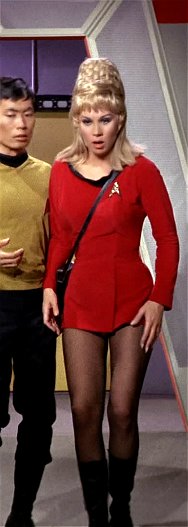 |
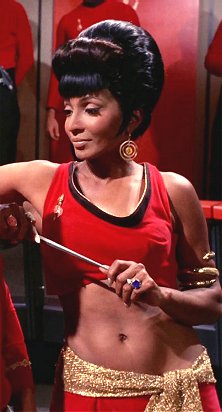 |
One
area where Star Trek made considerable progress and incorporation into its
substance was its regard towards minorities. Of course, by the late 1960's.
the Civil Rights Movement in the United States was in full swing and much
progress had been made in that area. By the time the first episode of the
series aired in 1966, Congress had passed numerous Civil Rights Acts, the
Voting Rights Act in 1965, and constitutional amendments outlawing the poll
tax and extending the right to vote in Presidential elections to the residents
of the District of Columbia, where the majority of the population is Black.
Thus, Star Trek was ripe for emphasis on the equality of all people regardless of race. Still, because of the population in the South that watched the show, and other factors, elements of racism and racial inequality still appear in the series. Lastly, Star Trek has one episode that appears to make a clear statement regarding America's Civil Rights Movement. To begin with, the crew of the Enterprise was racially mixed. "The ship had to be interracial because it represented all of mankind. How can the human race ever hope to achieve friendship with alien races if it can't even make friends with itself?". The series has two regular characters that represent American minorities rapidly gaining status in American society, Lt. Sulu and Lt. Uhura (previously discussed in her role as a woman). Mr. Sulu, played by George Takei, is the helmsman of the USS Enterprise. He first appeared in the second pilot 'Where No Man Has Gone Before' as 'physicist' Sulu where the character had very few lines that were not indicative of the 'adventure-loving, vital individual into which he would develop'. He is described in the episode 'Errand of Mercy' (airdate 3/23/67) as a 'capable combat officer' by Captain Kirk and Mr. Spock as Sulu is left commanding the Enterprise in battle against a formidable Klingon attack force. He is also a bit of an adventurist and a swashbuckler as is evident by his chivalrous swordplay in 'The Naked Time' (airdate 9/29/66). To have a Japanese-American in such an authority position was indeed a big step forward. Though hostile feelings in America towards Japanese-Americans due to World War II had cooled off significantly, some concern existed as to whether a Japanese-American character would cost the series viewers in Indonesia. Still, George Takei, like the other minority actors for Star Trek, fought and lobbied hard for his character. He was never happy with the lines and actions the writers had for his character and Takei pushed so hard for his character that producers and writers learned to watch out when he came around. Gene Roddenberry never viewed Sulu as a 'token Asian', even at a time when it seemed everyone was against him for insisting on a major role for his minority character. Lt. Sulu thus became an indispensible member of the Enterprise crew. It is difficult to imagine anyone else at the helm of the USS Enterprise that could perform the duties of helmsman as well as Sulu. The other minority regular on Star Trek was, of course, Lt. Uhura, communications officer of the Enterprise. Again, it must be stressed that it was a bold step on the part of Star Trek to have a Black character in such an important position on a television show during the 1960's. Uhura, whose name means 'freedom' was a Black-African princess from East Africa who was fluent in Swahili, not an American Black woman, and this added a certain mystique to her character. Just as Sulu was never intended to be a 'token Asian' for the benefit of certain viewers in the audience, Uhura never intended to be a 'token Black', and both Ms. Nichols and Gene Roddenberry sought to make sure of that. Unfortunately, pressure from network censors and writers often reduced her to simple lines like, "Hailing frequencies open, Captain" or "Captain, what is it?" However, of the major groundbreaking steps involving Lt. Uhura that Star Trek made in television history was television's first interracial kiss (widely acknowledged as such in the literature. The controversial kiss occurred during the episode 'Plato's Stepchildren' (airdate 11/22/68) where Captain Kirk, Mr. Spock, Dr. McCoy, Nurse Chapel, and Lt. Uhura are held captive by admirers of Earth's ancient Greek society who are also endowed with telekinetic powers. |
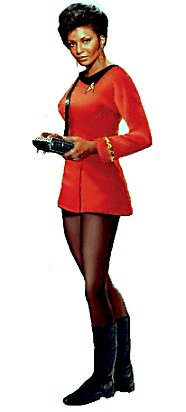 |
|
The script called for either Captain Kirk or Mr. Spock, under control of
his alien captors, to kiss Lt. Uhura. According to Fred Freiberger, producer
of the episode, the show was caught in a bind- if they had Spock kiss her,
the critics would say the show was too scared to have a White man kiss a
Black woman, and if they had Kirk with Uhura in the scene with no kiss,
then they would have gotten the same reaction. He and his colleagues made
the decision to "...have Kirk do it, and go as far as [they could] in terms
of censorship and all the rest of it". The kiss between Uhura and Kirk did make it on the air, and it apparently turned a lot of heads, but Ms. Nichols felt that the kiss was not all it was cracked up to be. She remarked once that Kirk was forced to kiss Uhura and, moreover, he was trying to fight against the pressure. Fan male after the episode was critical of the kiss, saying basically that if Captain Kirk had a beautiful woman in his arms, he would not be reluctant to kiss her. As is apparent, Star Trek did attempt to make bold steps with its minority regulars, but the steps fell far short of their intended effect. Star Trek does have a strong vein of racism running through it, but this racism is not directed towards the minority regulars (that would have caused major problems). Instead, this racism was directed towards Mr. Spock (portrayed by Leonard Nimoy), the half-Human half-Vulcan first officer and science officer of the Enterprise. Spock is the only one of his people aboard the Enterprise. His pointed ears, green blood and devotion to pure logic set him apart from the rest of the crew. As a Vulcan, a fictional race of beings, scathing comments regarding his ethnicity (and especially his pointed ears) could have been made with virtual impunity while similar comments directed toward recognised minority groups would have been greatly frowned upon. The relationship between Mr. Spock and Dr. McCoy makes this point clear. During practically every episode, McCoy badgers Spock about everything from his pointed ears to his green blood. During the episode 'Bread and Circuses' (airdate 3/15/68), Spock saved McCoy's life during a gladiator battle. McCoy later tries to humbly thank Spock for saving him, but he was put off by Spock's concentration on finding a way out of their jail cell and resorts to going back to his typical scathing remarks regarding Spock's physical characteristics (I forget the actual line, but it goes something like this: "I'm trying to thank you for saving my life, you pointy-eared Vulcan!!"). McCoy is not the only one to attack Spock's ethnicity. During the episode 'The Omega Glory' (airdate 3/1/68), Captain Ronald Tracey of the USS Exeter points to Spock's pointed ears and tries to convince his captors the Yangs that Spock is Satan, an endeavour that fails. And finally, in 'Balance of Terror' (airdate 12/15/66), "Lieutenant Stiles, a barely-concealed racist and reactionary who lost several ancestors in [the human's first war with the Romulan Star Empire], accuses Spock of being a Romulan sympathiser simply because Vulcans and Romulans have pointed ears. In the end, Spock risks his life to save Stiles and the bigot is instantly chastened and reformed". Attitudes like this towards Spock were tolerated because Nimoy was a White and his character a Vulcan, not a Black or a Hispanic or an Asian. Roddenberry had originally wanted to cast a Black man in Spock's role but it seems rather doubtful if the same remarks could have been made about Spock were he played by a Black. Lastly, one episode of Star Trek is a clear statement on racism and its inherent disutility. 'Let That Be Your Last Battlefield' (airdate 1/10/69) is about two half-white half-black beings from the planet Charon who bring their senseless racial struggle to the Enterprise. Lokai is the first to come aboard the Enterprise - he arrives in a stolen shuttlecraft asking for asylum. His pursuer, Bele, soon afterwards arrives on the Enterprise asking to take Lokai back to their home planet to stand trial for political crimes. Bele explains to Captain Kirk at one point his reason for wanting to take Lokai back to Charon. |
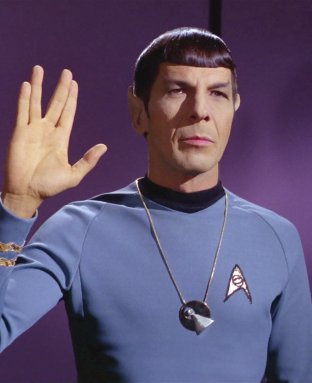 |
 |
Apparently Lokai and others like him are considered inferior because they
are black on the right side of their bodies while Bele's people are white
on that side (the difference is not apparent to Kirk and the rest of the
crew until Bele points it out, and the way it is pointed out makes it look
silly and arbitrary). He attempts to justify his people's treatment of Lokai
by saying they are well treated and well cared for by his people, but because
of their inherent inequality, they are not able to take care of themselves
and require paternal guidence from the 'superior' members of their society.
Later in the episode, Lokai gives a lecture to members of the bridge crew on racism and persecution - the bridge crew emphasising that racism and persecution existed at one time but was a thing of the past in their society. Bele eventually hijacks the Enterprise to Charon when his extradition request is denied by the Federation, but when the Enterprise reaches Lokai's and Bele's home planet, they find the entire population dead from a major war. Instead of putting aside their diferences, the two blame each other for the war and they end up beaming themselves back down to the planet to continue their senseless race war. The episode ends with Captain Kirk not acknowledging that either of them was right or wrong, but "all that mattered to them was their hate". The parallels between this episode and the Civil Rights struggle in America are uncanny. In the United States, in addition to people like Dr. Martin Luther King Jr. who were advocating peaceful change and Senator Stromm Thurmond of South Carolina who was advocating the status quo, extremist groups based on hatred and anger existed on the playing field. Malcom X, a radical Black activist, advocated a violent uprising by Blacks against Whites (in essence, 'Kill Whitey'!). There was also the Black Panthers, a militant Black organization that was prepared to seemingly start another civil war with all the weaponry it managed to procure. On the other side of the spectrum, there were the Ku Klux Klan and other White hate groups. What all these individuals and groups have in common is a fierce, uncontrollable hatred of those opposed to them, much like Bele and Lokai in this episode. The message to them is simple: hatred and violence will bring about everyone's destruction. Indeed, it was peaceful change that eventually brought about the major reforms in civil rights in this country, not the violent uprisings or suppressions that the extremist groups advocated. Thus, Star Trek appears to have made many contributions to the improvement in race relations in America. Minority characters in clearly important positions emphasising the equality of minorities were combined with a 'safety-valve' in the form of Mr. Spock to act as an outlet for racist attitudes. And of course, one episode does get to make a direct comment on race relations in America. More than likely it is Star Trek's quality of remoteness of time and location that gives it the ability to do this without overtly appearing to be a social commentary. Of all the social issues that Star Trek alludes to or addresses, the one it seems to spend the most time on is the ethics of war and peace. Star Trek ran during the escalation period of the Vietnam war, a time when relations among the superpowers were tense. It takes numerous opportunities to make comments and address war and peace issues, overall criticising use of force or the threat of it to achieve policy. |
| Star Trek sets
up and develops, throughout the series, striking parallels between the United
Federation of Planets and the 'West', and the Klingon Empire and the Romulan
Star Empire as the 'East'. The series also has episodes that do not involve
either of the Federation's enemies, but still make forceful comments on
the evils of militarism. The United Federation of Planets, the governing body in Star Trek with the Enterprise belonging to its military service Starfleet, is a product of the second season of Star Trek - prior to this, the governing body of Star Trek is a united Earth government. Terry Worland in his article 'Captain Kirk: Cold Warrior' offers an enlightening discussion of the relationship between the Federation and its adversaries. During the first season, the Enterprise has a few isolated skirmishes with both enemies, but as soon as the Federation is introduced, conflict between them takes on an ideological flavour in the episodes. "It became clear that the Federation controlled a definite sphere of influence and a vital interest [that was being] continually challenged and threatened". Moreover, Wortland believes that the Federation is not another United Nations, a rather weak organisation with limited tools for achieving policy, but rather resembles the 'free world' being defended by Starfleet, representative of NATO and the United States. "If the Federation represents America and the Western alliance, consider that during the time of Star Trek's production the U.S. government was seeking to challenge two principal adversaries in the Third World, especially in Vietnam". According to David Gerrold, just as America was supposed to be the policeman for the world, Star Trek is the policeman for the galaxy, all at a time when it was being questioned whether or not America should play that role. Starfleet's originally scientific mission becomes one to 'spread truth, justice and the American Way to the far corners of the universe' as well as to defend the Federation against its cancerous adversaries. Just as the Federation comes to represent the 'West' of 20th century earth, The Klingons seemingly come to represent America's staunchest adversary - the Soviet Union. William Blake Tyrell in his essay 'Star Trek as Myth and Television as Mythmaker' compares the Klingons and the Romulans to the Indian tribes the U.S. fought in the western part of the country. The Klingons are the "Magua - sly, perfidious, and fallen" while the Romulans are the "Chingachgook, the noble warrior ever outside the white man's world". However, I believe that given the time period in which Star Trek ran on NBC that examination of both the Klingons and the Romulans in terms of 1960's superpower relations provides a better interpretation of these two forces. The Klingons are a race of warriors from a part of the galaxy contiguous to Federation territory. They are thoroughly rotten creatures capable of such brutality and violent conquest as to make Josef Stalin in the Soviet Union seem like a mere street corner bully. "Think of the Mongol Hordes with spaceships and ray guns. To the Klingons, Genghis Khan was a phony and Attila the Hun was a fairy. And Hitler was only a beginner". They seem to live by the maxim that "rules are made to be broken by shrewdness, deceit or power". The Klingons are ruthless, planet-conquerers who use violent means to colonise 'third-worlds'. Kor, the Klingon commander 'Errand of Mercy' (airdate 3/23/67), establishes Klingon rule on Organia with an iron hand, issuing orders banning public gatherings of more than two people and a whole host of other repressive measures. Klingons are also creatures of duty and fatality- the hope of every Klingon is to die in battle. During the episode 'Day of the Dove' (airdate 11/1/68), Kang, the Klingon commander of a small force holding part of the Enterprise, responds to Kirk's threat to kill his wife with a fatalistic statement that she knows the cost of final victory and is willing to pay with her life in order to further the greater glory of the empire. According to Worland, the Federation is locked in a 'Cold War' with the Klingon Empire over the colonisation of 'third worlds' and, moreover, the Federation is committed to stopping the spread of 'Klingonism' at all costs. Indeed, the Federation does conflict with the Empire over developing planets in the episodes 'The Trouble with Tribbles' (airdate 12/29/67) and 'Friday's Child' (airdate 12/1/67). However, one episode of Star Trek including a battle with the Klingons over a developing planet that makes a seemingly direct comment on the Vietnam War is 'A Private Little War' (airdate 2/22/68). In this episode, Kirk, Spock and McCoy beam down to a planet in the Organian-imposed neutral zone where Kirk was once stationed. They find the Hillpeople and the Villagers engaged in a war and, strangely, the Villagers have flintlock rifles - weapons they could not have possibly developed in Kirk's absence. Kirk suspects the Klingons of supplying the Villagers with their relatively advanced weaponry but he needs absolute proof. After obtaining that proof, and a few flintlocks to boot, Kirk returns to the Hillpeople's camp to arm them with the exact same weaponry. He justifies his action to Dr. McCoy by referring to the "20th century brush wars on the Asian continent" and noting that the only way to deal with the situation then was to maintain the balance of power between the two opposing sides. Kirk feels that he must do the same thing now as was done then in order to fight the Klingons. But, by the end of the story, Kirk realises that he has opened a Pandora's box by arming the Hillpeople and does not arm them anymore than he already has. |
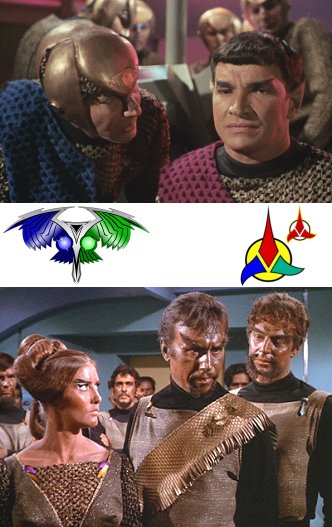 |
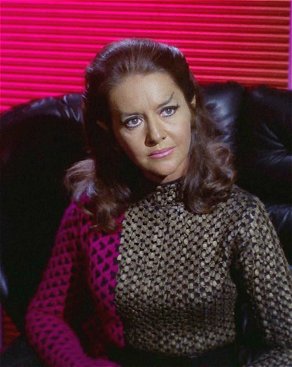 |
Oddly enough,
this episode was broadcast during the Tet offensive, the bloody two month
long attack by the Viet Cong on every major city in the Republic of Vietnam,
including Saigon. This is widely acknowledged as the turning point of the
Vietnam War as far as American public opinion is concerned. In this episode,
"[Kirk] adopts the rhetoric of five presidential administrations in describing
the causes of a civil war and the rationale for American/Federation involvement".
Here, the Hillpeople come to represent the South Vietnamese as the U.S.
government would have liked the public to view them - peaceful, unaggressive
and good-natured. Likewise, the Villagers come to represent the North Vietnamese and the Viet Cong who readily take aid from the Klingons/Soviet Union. However, Wortland believes that Star Trek stopped just short of making a strong comment on the war. Instead, he feels the episode is ambivalent, wavering between a pro and anti war stance. Because of this, both sides probably labeled it as either "treasonous" or "sharp criticism [of the war]". Either way, it seems that this episode was lucky to make it on the air given this very touchy subject. The Klingons are not the only adversaries the Federation face. On the other side of Federation space lay the Romulan Star Empire. The Romulans are not seen very much during the course of the series. Apparently, the humans and the Romulans fought a major interplanetary war to a stand-off, then negotiated a treaty calling for the establishment of a neutral zone that entrance into by either side constituted an act of war. The Romulans are creatures of pure duty, more so than the Klingons. In 'Balance of Terror' (airdate 12/15/66), an episode during which the Enterprise and a Romulan warship engage in a battle, the commander's final act is to destroy his disabled ship to avoid the disgrace of capture. Comparatively, the Romulans are a regional power, but also one not to be taken lightly; allied with the Klingon Empire, they copy Klingon warship design in 'The Enterprise Incident' (airdate 9/27/68). The Romulans were not as repulsive as the Klingons were, but they were much smarter than their Klingon counterparts. They are also not completely despised as the Klingons are, principally because they and Mr. Spock have the same distant ancestors.
|
|
Note:
A full list of references and the works cited in this article (that have
been removed for easier reading) can be found in Will Snyder's original
full article, viewable via his home
page
|
|
|
All
Original Material Copyright SixtiesCity
Other individual owner copyrights may apply to Photographic Images |